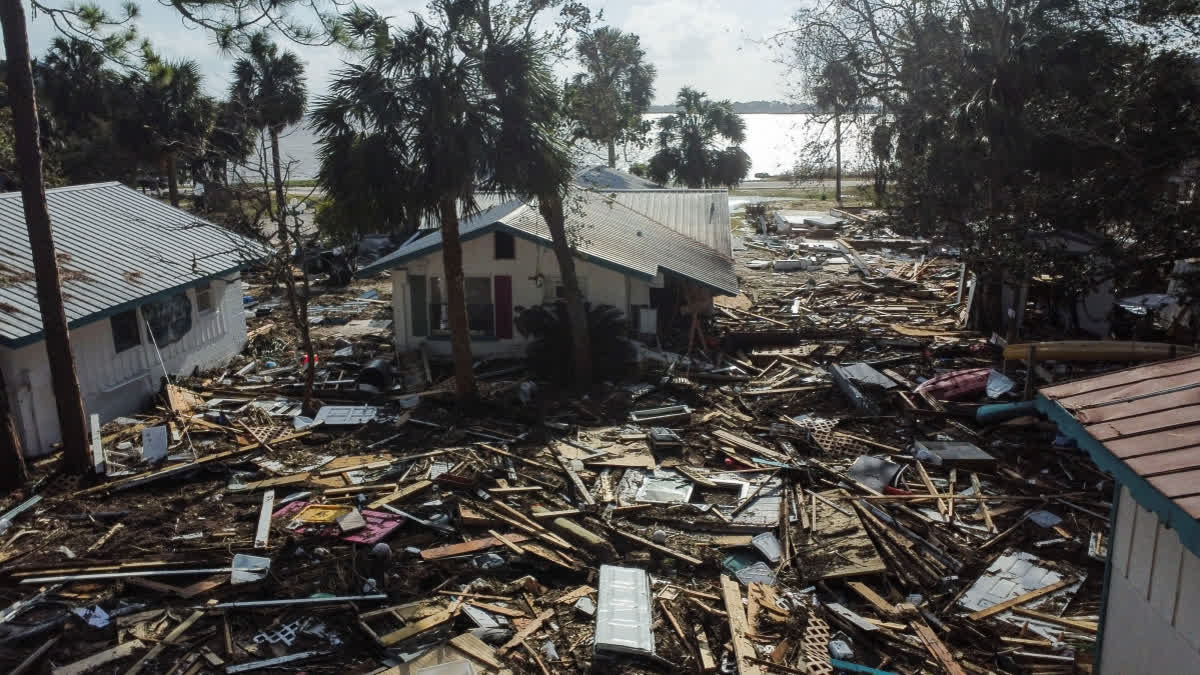Perry (US): Hurricane Helene caused at least 52 deaths and billions of dollars of destruction across a wide swath of the southeastern U.S. as it raced through, and more than 3 million customers went into the weekend without any power and for some a continued threat of floods.
Helene blew ashore in Florida's Big Bend region as a Category 4 hurricane late Thursday packing winds of 140 mph (225 kph) and then quickly moved through Georgia, the Carolinas and Tennessee, uprooting trees, splintering homes and sending creeks and rivers over their banks and straining dams.
Western North Carolina was essentially cut off because of landslides and flooding that forced the closure of Interstate 40 and other roads. The video shows sections of Asheville underwater. Francine Cavanaugh said she has been totally unable to reach her sister, son, or friends in the Asheville area.
“My sister checked in with me yesterday morning to find out how I was in Atlanta,” she said on Saturday. “The storm was just hitting her in Asheville, and she said it sounded really scary outside.”
Cavanaugh said her sister had no idea how bad the storm would be there. She told Cavanaugh she was going to head out to check on guests at a vacation cabin “and that’s the last I heard of her. I’ve been texting everyone that I know with no response. All phone calls go directly to voicemail.” She saw video of a grocery store near the cabins that was completely flooded.
“I think that people are just completely stuck, wherever they are, with no cell service, no electricity.” There were hundreds of water rescues, none more dramatic than in rural Unicoi County in East Tennessee, where dozens of patients and staff were plucked by helicopter from the roof of a hospital that was surrounded by water from a flooded river.
The storm, now a post-tropical cyclone, was expected to hover over the Tennessee Valley on Saturday and Sunday, the National Hurricane Center said. Several flood and flash flood warnings remained in effect in parts of the southern and central Appalachians, while high wind warnings also covered parts of Tennessee and Ohio.
At least 48 people have been killed in the storm; among them were three firefighters, a woman and her 1-month-old twins, and an 89-year-old woman whose house was struck by a falling tree. According to an Associated Press tally, the deaths occurred in Florida, Georgia, North Carolina, South Carolina and Virginia.
In the wealthy enclave of Davis Islands in Tampa, where star athletes like Derek Jeter and Tom Brady have lived, residents were continuing to clean up Saturday from storm surge left by Helene. The neighborhoods that sit just off Tampa’s downtown and are home to about 5,000 people had never seen storm surge like it had Friday. No one died, but homes, businesses and apartments were flooded.
”I don’t think anybody was expecting it,” Faith Pilafas told the Tampa Bay Times. “We’ve kind of gotten accustomed to lots of talk about big storms, and never actually like feeling the effects of it. So for all the people who didn’t leave the island, I feel like they were all just expecting it to be a normal storm, anticlimactic. And wow, were we surprised.”
Evacuations and record rainfall
Authorities warned residents to evacuate, and many did, but some stayed behind. In North Carolina, a lake featured in the movie “Dirty Dancing” overtopped a dam and surrounding neighborhoods were evacuated, although there were no immediate concerns it would fail. People also were evacuated from Newport, Tennessee, a city of about 7,000 people, amid concerns about a dam near there, although officials later said the structure had not failed.
Tornadoes hit some areas, including one in Nash County, North Carolina, that critically injured four people. Atlanta received a record 11.12 inches (28.24 centimeters) of rain in 48 hours, the most the city has seen in a two-day period since record keeping began in 1878, Georgia’s Office of the State Climatologist said on the social platform X. Some neighborhoods were so badly flooded that only car roofs could be seen poking above the water.
Moody’s Analytics said it expects $15 billion to $26 billion in property damage. Climate change has exacerbated conditions that allow such storms to thrive, rapidly intensifying in warming waters and turning into powerful cyclones sometimes in a matter of hours.
